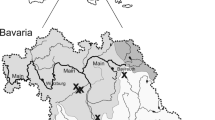Abstract
The presence of the non-indigenous species, the black-pygmy mussel Xenostrobus securis, is reported here for the first time in an intense shellfish farming area off Galicia (NW Spain). Very high concentrations of this mytilid bivalve have colonized estuarine waters located at the inner part of the Ria de Vigo. The invasive role of X. securis is discussed in the context of the wide ecological tolerance of the species and the recent finding of settlements of this species on numerous colonies of the economically-important blue mussel Mytilus galloprovincialis. The mode of introduction of the black-pygmy mussel is also discussed in relation to human management activities.


Similar content being viewed by others
References
Darrigran G (2002) Potential impact of filter-feeding invaders on temperate inland freshwater environments. Biol Invasions 4:145–156
Kimura T, Kakuta T, Kurokura H (1995) Salinity tolerance and osmoregulation in freshwater and brackish water mytilids (Mytilidae: Genus Limnoperna). Bull Soc Sea Water Scientist Jpn 49:148–152
Kimura T, Masaaki T, Yasuhiro S (1999) Limnoperna fortunei kikuchii Habe, 1981 (Bivalvia: Mytilidae) is a synonym of Xenostrobus securis (Lamarck, 1918): introduction into Japan from Australia and/or New Zealand. Japanese Jpn J Malacol 58:101–117
Kohama T, Montani S, Kajiwara Y, Yamada M (2001) Population dynamics of sessile bivalves Mytilus galloprovincialis and Xenostrobus securis in hyper eutrophicated bay, Japan. Bull Jpn Soc Fish Sci 67:664–671
Lazzari G, Rinaldi E (1994) Alcune considerazione sulla presenza di specie extra Mediterranee nelle lagune salmastre di Ravenna. B Malacol 30:195–202
Mack R, Simberloff D, Lonsdale M, Evans H, Clout M, Bazzaz F (2000) Biotic invasions: causes, epidemiology, global consequences, and control. Ecol Appl 10:689–710
Morton B (1996) The aquatic nuisance species: a global perspective and review. In: D’itri F (ed) Zebra mussels and other aquatic species. Ann Arbor, Press, Ann Arbor, pp 1–54
Ricciardi A (2003) Predicting the impacts of an introduced species from its invasion history: an empirical approach applied to zebra mussel invasions. Freshw Biol 48:972–981
Rolán E (1992) Dos especies más de moluscos mediterráneos introducidas en la bahía de O Grove (Galicia, España). Thalassas 10:135
Rolán E, Trigo J, Otero-Schmitt J, Rolán-Álvarez E (1985) Especies implantadas lejos de su área de distribución natural. Thalassas 3:29–36
Rolán E, Pérez-Sixto JL, García-Caballero R (1994) Nuevas citas de moluscos para la Ría de Vigo. Noticiario de la Sociedad Española de Malacología 20:19–21
Russo P (2001) Grande concentrazione di Xenostrobus securis (Lamarck, 1819) in varie zone del Delta del Po. Conchiglia 298:49–50
Sabelli B, Speranza S (1994) Rinvenimento di Xenostrobus sp. (Bivalvia, Mytilidae) nella laguna di Venecia. B Malacol 29:311–318
Shea K, Chesson P (2002) Community ecology theory as a framework for biological invasions. Trends Ecol Evol 17:170–176
SEBI2010-Streamlining European 2010 Biodiversity Indicators. http://www.biodiversity-chm.eea.europa.eu/information/indicator/F1090245995/F1115192484/fol712457
Wilson BR (1967) A new generic name for the three recent and one fossil species of Mytilidae (Mollusca: Bivalvia) in southern Australia, with redescriptions of the species. Publ Malacol Soc Lond 37:279–295
Acknowledgements
We specially would like to thank E. Rolán, J.M. Vieitez and C. Salas for their help in species identification. The authors are indebted to two anonymous referees for improving the manuscript.
Author information
Authors and Affiliations
Corresponding author
Rights and permissions
About this article
Cite this article
Garci, M.E., Trigo, J.E., Pascual, S. et al. Xenostrobus securis (Lamarck, 1819) (Mollusca: Bivalvia): first report of an introduced species in Galician waters. Aquacult Int 15, 19–24 (2007). https://doi.org/10.1007/s10499-006-9062-1
Received:
Accepted:
Published:
Issue Date:
DOI: https://doi.org/10.1007/s10499-006-9062-1




